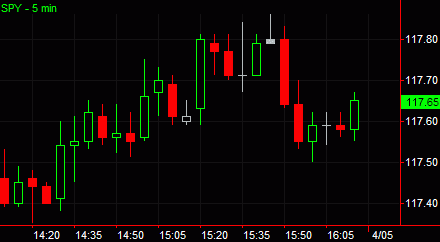
TradeStation Help
Candlestick charting is an art form that has been passed down from the 1600s when it was used to trade Japanese rice futures. The name "candlestick" is used because the data in the charts are plotted to resemble what looks like a series of candles with wicks. Candlestick charting places a great deal of importance on the relationship between the open and closing prices for each bar.
The candlestick chart uses the same price data as a bar chart, with each candlestick representing the open, high, low and closing price. The "thick" part of the candlestick is known as the "real body" and represents the range between the open and closing prices. A hollow real body represents a bullish market - the close price was higher than the open price. A filled real body represents a bearish market - the close was lower than the opening price. The thin line above the body represents the high, and the thin line below the body represents the low.
A candlestick chart can be drawn with any data interval (except 1-tick bars). You are also able to apply any analysis technique to a candlestick chart that you can apply to a bar chart. When evaluating candlestick patterns, you can evaluate individual candlesticks or groups of candlesticks.

The following candlestick styles are available from the Format Symbol > Styles window:
Candlestick with Trend -Displays candlestick bars with hollow/filled bodies where the bar color is used to indicate the trend direction. By default, green indicates an up trend where the current bar Close is greater than the previous Close, red indicates a down trend where the current bar Close is less than the previous Close, and grey indicates no change in Close from the previous to current bar.
Candlestick - Displays candlestick bars that as always filled where the bar color is used to show the hollow or filled bar state. By default, green indicates an up body (hollow) candle where the current bar Close is greater than the current bar Open, red indicates a down body (filled) candle where the current bar Close is less than the current bar Open, and gray for the wick above and/or below the body.
![]() For
a comprehensive list of commands line commands, see Command Line References (All Commands) or Command
Line Reference (Sorted by Application).
For
a comprehensive list of commands line commands, see Command Line References (All Commands) or Command
Line Reference (Sorted by Application).